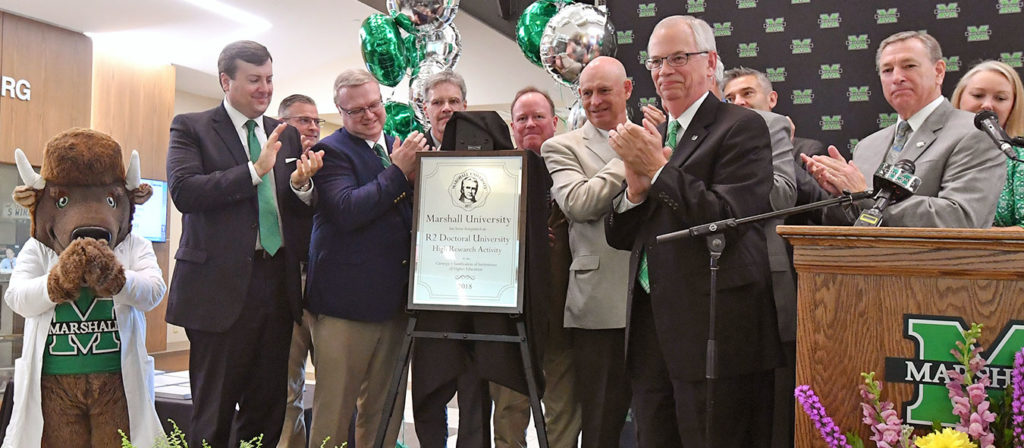Marshall University President Jerome A. Gilbert joined Vice President for Research John M. Maher, West Virginia Higher Education Policy Commission Chairman Michael J. Farrell and university mascot Marco to unveil a plaque commemorating the university’s climb in the Carnegie Classification of Institutions of Higher Education.
The Carnegie classification is the basic framework for categorizing colleges and universities in the United States. Carnegie recently designated Marshall a “Doctoral University: High Research Activity,” or “R2” as it is commonly called in higher education circles. The designation places Marshall among the top six percent of college and universities in the nation, and is the second-highest classification an institution can receive from the organization.
During today’s ceremony, which also included music by a student jazz band and a reception, Gilbert noted that research expenditures at Marshall have increased 35 percent over the past two-and-a-half years from $23 million to $31 million, and are expected to climb even further this year.
Gilbert told the gathered researchers, students and administrators, “I am very proud of the continued progress of our programs and of Marshall University as a whole. Increasing our research activity has been one of my goals since arriving at Marshall and it continues to be a priority.
“As most of you know, I come from a research faculty background myself. I’ve been where you are. I know what it’s like to toil in the lab—trying to balance teaching, scholarship and service. It’s not easy. But it is rewarding. I thank each and every one of the researchers here today for your contributions to getting us to this moment.”
Marshall was previously classified as a “M1: Master’s Colleges and Universities – Larger Programs,” but with the university’s increased research productivity and a move by the Carnegie program to include additional doctorates in its methodology, Marshall’s designation jumped up two levels to R2.
During his remarks, Maher said, “The plaque we are unveiling here today will be mounted to the wall in Old Main, next to the president’s office, as a visible sign to visitors and the Marshall community of our accomplishments and our drive to continue to succeed.”
For its latest rankings, Carnegie surveyed more than 4,000 universities and put just 139 in the R2 category, which includes universities that confer at least 20 research/scholarship doctorates annually and spend a minimum $5 million per year on research. With its R2 designation, Marshall joined the likes of universities such as Baylor, Wake Forest and Lehigh.
Farrell, who is a Marshall graduate, said, “It is indeed an exciting time for Marshall University. When I was student body president at Marshall in 1967, President Stewart Smith invited me to serve as the first student to serve in the presidential cabinet. If we had thought in 1967 that I would be here today, that we would be here today, with this new research status, it would be a great shock. Although those were the expectations that we harbored, there were those who said ‘It won’t be done. It can’t be done.’ I give credit to President Gilbert, John Maher, to the deans, to the researchers, to the students, that you did not listen to those who wanted to define our expectations as something much lower than we have now achieved.
“The state of West Virginia needs Marshall University to be strong, It needs Marshall to be a leader. It needs Marshall to stand up and be counted. The Higher Education Policy Commission thanks you and salutes you for this hard work.”
The celebration was held in the J. Churchill Hodges Atrium of the Arthur Weisberg Family Applied Engineering Complex on Marshall’s Huntington campus.
Originally from Ginny Painter for Marshall University Communications.
